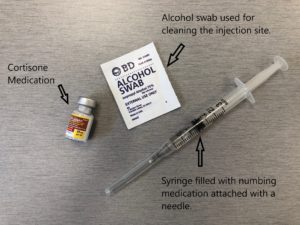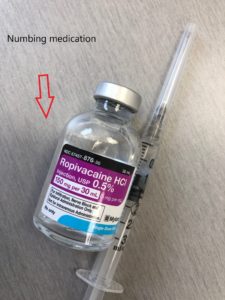Cortisone Injection
Cortisone or corticosteroid injections are commonly given to reduce the pain and inflammation at the site of injection. The cortisone shots are widely given in the knee and the shoulder joint, but may be given in other joints as well. The injection may be given in the elbows, hips, ankle, wrist, spine, etc.

Cortisone vial, alcohol swab, and the syringe.
Conditions
The injection is most commonly given for osteoarthritis by orthopedic surgeons. The injection may also be used for joint pain caused by inflammatory arthritis such as rheumatoid arthritis and psoriatic arthritis. The shots may also be given for painful joint conditions such as gout. The steroid injections are helpful in back pain and inflammation of bursae and tendons.
Mechanism of action
The injections contain a steroid medication that is delivered locally in the joint, tendon, or bursae. The adrenal glands naturally release the steroid in the body. The steroids help to dampen the immune system and reduce inflammation. The reduction in inflammation leads to relief from pain and swelling.
Benefits of Cortisone Injections
Cortisone injections offer several benefits for individuals suffering from knee pain:
Pain Relief: Cortisone injections can provide significant pain relief, allowing you to resume activities that were previously difficult due to knee discomfort.
Improved Mobility: By reducing inflammation, cortisone injections can improve knee joint function and increase range of motion, making it easier to move around.
Non-Surgical Option: Cortisone injections offer a non-surgical alternative for managing knee pain, avoiding the need for invasive procedures in many cases.
Fast Acting: Many people experience relief shortly after receiving a cortisone injection, with the full effects usually kicking in within a few days to a week.
Long-lasting Relief: While cortisone injections may not provide permanent relief, the effects can last for several weeks to several months, allowing you to enjoy an extended period of pain-free living.
Procedure
The patients may receive a cortisone shot in the doctor’s office as an outpatient procedure. Before the procedure, the physician ensures that the patient is not on any blood thinners and is not having any active infection. Diabetic patients must have their blood sugar levels well-controlled before the shot as the blood sugar levels may shoot up after the injection.

Numbing medication is usually injected along with the cortisone to provide immediate pain relief.
The patient is positioned for easy access to the involved joint. The site of injection and the adjacent area is cleaned with a povidone-iodine solution. Numbing medication is applied to the location of injection, to make it the injection less painful.
The physician marks the site of needle insertion with a sterile marker, and the injection is delivered. The injection site is covered with a sterile dressing. Often the physician might also use ultrasound guidance to deliver the injection at the correct location.
Post injection, the patient is advised to apply ice and take over the counter nonsteroidal anti-inflammatory and pain medications as needed for 1-3 days. Pain and redness are common short term side effects after injections and usually subside within 1-2 days. Patients are advised to keep the dressing dry for at least a day and avoid hot tub baths for a day. The patients are also encouraged to watch for any signs of infection.
Risks
Frequent cortisone shots are avoided as they may cause long term damage to the cartilage of the joint. The local steroid may also cause the death of the nearby bone and thinning/weakening of the bone. The cortisone may cause thinning of the skin and the adjoining soft tissues.
The steroid injection may be associated with an increased risk of joint infection and damage to the surrounding nerves. Multiple steroid injections may cause tendons to weaken and rupture. Immediately after the injection, there may be increased pain and inflammation, which is easily managed with pain relievers. There may be temporary facial redness, and the blood sugar may shoot up in diabetic patients.
Results
The anti-inflammatory effect of the cortisone shot which results in pain relief may take a few days to kick in. The majority of the patients experience significant relief after a few days. The reduction in pain and swelling may last for several months or even a year. However, some patients may need repeated cortisone shots as the drug effect wears off.
Conclusion
Cortisone injections can be an effective treatment option for managing knee pain and inflammation. By reducing inflammation in the knee joint, these injections can provide significant relief, allowing you to enjoy improved mobility and a better quality of life. While cortisone injections are generally safe, it’s essential to discuss the potential risks and benefits with your healthcare provider to determine if this treatment is right for you. With proper care and monitoring, cortisone injections can help you get back to doing the things you love without being held back by knee pain.
Do you have more questions?
How long does it take for cortisone injections to start working?
Cortisone injections typically start providing relief within a few days to a week after the injection.
How often can cortisone injections be administered?
Cortisone injections can be given every few months if necessary, but frequent injections may increase the risk of side effects.
Are cortisone injections suitable for all types of knee pain?
Cortisone injections are most effective for knee pain caused by inflammation, such as arthritis, bursitis, and tendinitis. They may not be as effective for other types of knee conditions, such as structural damage or severe degeneration.
Can cortisone injections be used alongside other treatments?
Yes, cortisone injections can be used in conjunction with other treatments such as physical therapy, medications, and lifestyle modifications to manage knee pain effectively.
Are cortisone injections painful?
The injection itself may cause some discomfort, but most people find the procedure tolerable. Your healthcare provider may use a local anesthetic to numb the area beforehand.
How long does the pain relief from cortisone injections last?
The duration of pain relief varies from person to person but can last from several weeks to several months.
Can cortisone injections cure knee pain permanently?
Cortisone injections provide temporary relief by reducing inflammation, but they do not cure the underlying cause of knee pain.
Are there any alternatives to cortisone injections for knee pain relief?
Yes, alternatives include physical therapy, oral medications, hyaluronic acid injections, platelet-rich plasma (PRP) therapy, and surgical options for severe cases.
How soon after a cortisone injection can I resume normal activities?
You may be able to resume normal activities immediately after the injection, but it’s best to avoid strenuous activities for a day or two to allow the medication to take effect.
Can cortisone injections cause weight gain?
Cortisone injections can cause temporary fluid retention, which may lead to slight weight gain in some individuals. However, this effect is usually minor and resolves on its own.
Are cortisone injections safe for long-term use?
While cortisone injections are generally safe for occasional use, long-term use may increase the risk of side effects such as joint damage and osteoporosis. Your healthcare provider will monitor your condition and adjust treatment accordingly.
Can cortisone injections worsen knee pain?
In rare cases, cortisone injections may initially worsen symptoms before providing relief. This is known as a “cortisone flare” and usually resolves on its own within a few days.
Are cortisone injections effective for all types of arthritis?
Cortisone injections can provide relief for arthritis-related knee pain, but their effectiveness may vary depending on the type and severity of arthritis.
Can cortisone injections be used to treat knee pain in children?
Cortisone injections may be considered for children with severe knee pain caused by conditions such as juvenile arthritis, but they are typically used cautiously and under close medical supervision.
How do cortisone injections compare to other knee pain treatments in terms of effectiveness?
Cortisone injections are often effective for providing short-term pain relief and reducing inflammation. However, their effectiveness may vary depending on individual factors and the specific cause of knee pain.
Can cortisone injections be used to treat knee pain during pregnancy?
Cortisone injections are generally avoided during pregnancy unless the benefits outweigh the potential risks. Alternative treatments may be considered for managing knee pain during pregnancy.
Are cortisone injections covered by insurance?
Cortisone injections are typically covered by insurance when deemed medically necessary for the treatment of knee pain. However, coverage may vary depending on your insurance plan and specific circumstances.
Can cortisone injections be used to treat knee pain in athletes?
Cortisone injections may be considered for athletes with knee pain caused by inflammation or overuse injuries. However, it’s essential to weigh the potential benefits and risks, especially in high-performance athletes.
Can cortisone injections interfere with other medications I’m taking?
Cortisone injections may interact with certain medications, so it’s essential to inform your healthcare provider about all medications, supplements, and herbal remedies you are taking before receiving a cortisone injection.
How long does it take for cortisone injections to wear off?
The effects of cortisone injections typically wear off gradually over time, ranging from several weeks to several months, depending on individual factors and the specific condition being treated.
Can cortisone injections be used to treat knee pain in older adults?
Cortisone injections can be used to treat knee pain in older adults, but they may be used cautiously due to the increased risk of side effects such as osteoporosis and joint damage.
Can cortisone injections be used to treat knee pain in individuals with diabetes?
Cortisone injections can be used to treat knee pain in individuals with diabetes, but close monitoring of blood sugar levels is essential, as cortisone injections can temporarily raise blood sugar levels.
Are cortisone injections effective for all types of knee injuries?
Cortisone injections may be effective for certain types of knee injuries, such as ligament sprains, tendonitis, and bursitis, but their effectiveness may vary depending on the specific injury and individual factors.
Can cortisone injections be administered by a primary care physician, or do I need to see a specialist?
Cortisone injections can be administered by a primary care physician or a specialist such as an orthopedic surgeon or rheumatologist, depending on your specific healthcare needs and the availability of services in your area.

Dr. Suhirad Khokhar
My name is Dr. Suhirad Khokhar, and am an orthopaedic surgeon. I completed my MBBS (Bachelor of Medicine & Bachelor of Surgery) at Govt. Medical College, Patiala, India.
I specialize in musculoskeletal disorders and their management, and have personally approved of and written this content.
My profile page has all of my educational information, work experience, and all the pages on this site that I've contributed to.
